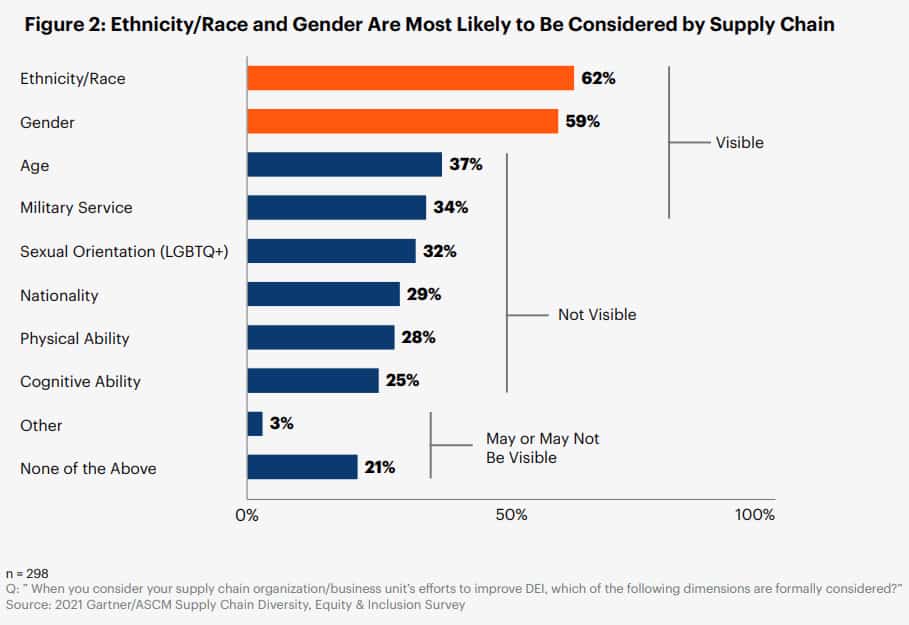Even as the US continues to be rocked by issues around race and gender equality, Asia’s own record on both topics remains abysmal, according to the United Nations Development Programme (UNDP).
A joint study by Gartner and the Association for Supply Chain Management (ASCM) of supply chain organisations in North America and Europe found that while over half of supply chain organisations have improving diversity, equity and inclusion (DEI) as an objective or goal, only a quarter have formal targets.
In the Supply Chain Diversity, Equity and Inclusion Survey of 298 supply chain professionals from November through December 2020, 59% of surveyed supply chain organisations reported having some form of an objective to improve any dimension of DEI - race/ethnicity, gender, LGBTQ+, physical and cognitive ability, veteran status or age - and 23% of those organisations have formal target or goals included in management scorecards.

Consumer and retail organisations are more likely than other industry sectors to either have a general objective for DEI or formal targets or goals. Company size plays a role when it comes to the dedication of senior leadership to improve DEI.
The largest supply chain organisations are far more likely to have DEI objectives - particularly formal targets or goals - than their smaller peers. Only 24% of small business supply chains have improved DEI as an objective.
“This makes sense when you look at the social justice movements of 2020. The largest global companies have globally recognizable brands, so they were under a lot of pressure to take action,” said Dana Stiffler, vice president analyst with the Gartner Supply Chain Practice.
She added that in a global organisation, it’s more likely they’ll have a DEI officer or an HR leader that owns and cascades the DEI strategy. “Where this is not happening fast enough, some chief supply chain officers (CSCOs) have designed and launched their own initiatives,” she continued.
ASCM CEO Abe Eshkenazi added that building a diverse workforce is essential, not aspirational.
“Diversity of thought, influence and input — particularly from women and people of colour — is crucial to today’s global supply chains,” he added.
Declining POC representation going up the corporate ladder
While people of colour (POCs) make up 30% of the overall supply chain workforce, their representation declines dramatically on the upper parts of the corporate ladder. Only 9% of vice presidents in supply chain organisations in the U.S., Canada, and Europe are people of colour.
Stiffler said POC representation already starts to drop at the very first level of leadership. “Compared to the overall representation in the workforce, there’s nearly a 50% drop once at the manager and supervisor positions. This trend then continues in the upper parts of the career ladder,” she continued.
Eshkenazi opined that this is a systemic issue that goes back to the 1970s, ’80s and ’90s that unfortunately isn’t unique to the supply chain. As the supply chain emerged as a function, many of its management and employees migrated from other functions such as finance and engineering, which due to their own narrow talent pipelines were primarily staffed with white males.
“As in many fields, more progress is needed. Supply chain organisations can lead the way by creating an environment where diverse talent is valued, included and developed,” he added.
The biggest differences in POC representation are not between industries, but again between organisation sizes. Large supply chains with annual revenue of $5 billion or more show a greater representation of people of colour than any of their smaller peers at all levels of the organisation.
Gartner’s Stiffler commented that in the largest global supply chain organisations, 13% of vice president positions are occupied by people of colour, compared to 6% in small businesses.
“While large, global organisations clearly benefit from better access to diverse talent, they’re also putting in the work to practice inclusion in leadership development and succession planning,” she added.
However, the coronavirus pandemic has prompted a change in workplace culture which might provide smaller businesses with the opportunity to catch up.
“Due to the rise of remote and hybrid work, even smaller supply chain organisations will have the opportunity to hire diverse talent, simply because the available talent pool is bigger and more diverse,” Stiffler continued.
Concrete actions lead to progress
Once supply chain organisations have goals and objectives, those should translate into specific projects and initiatives.
DEI is particularly vulnerable to statements and goals that are not always backed up by actions. Thirty-six per cent of respondents said that the supply chain organisation is leading initiatives, while 20% said their company has enterprise-wide initiatives. This leaves 44% who don’t have any kind of initiative or are still considering starting one.
Stiffler believed that the most successful initiatives are those that are integrated in the recruiting and pipeline planning process. In recruiting, that means diverse interview panels, diversity referral programs, summer internship programs for diverse students, blind resumé reviews and diverse campus recruiting.
“In integrated pipeline planning, it means re-designing recruiting, development, performance management, and succession planning to reduce bias,” she concluded.
For his part, Eshkenazi observed that prior to the pandemic, demand for supply chain professionals exceeded supply by a ratio of six to one.
“This need will only continue to grow, which is why it’s critical that teens have access to education and mentorship about career opportunities in supply chain regardless of their gender or colour,” he opined.




